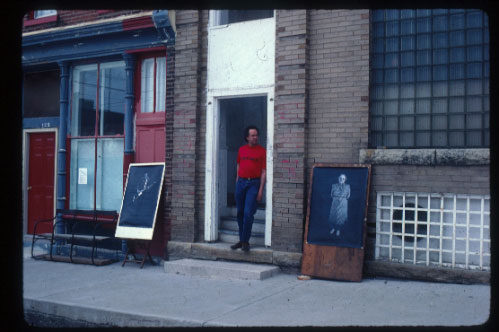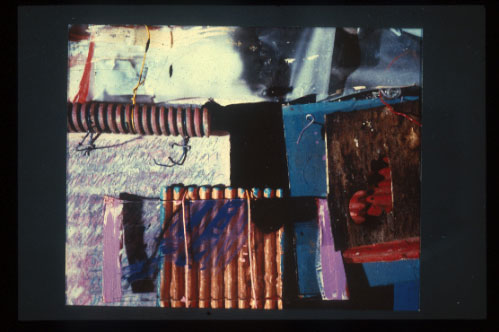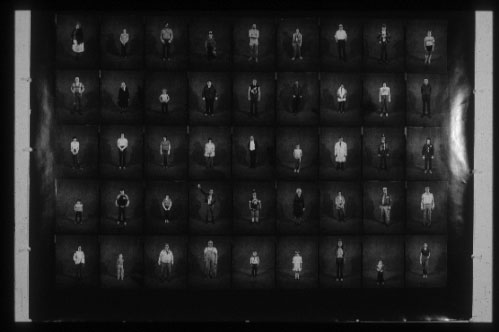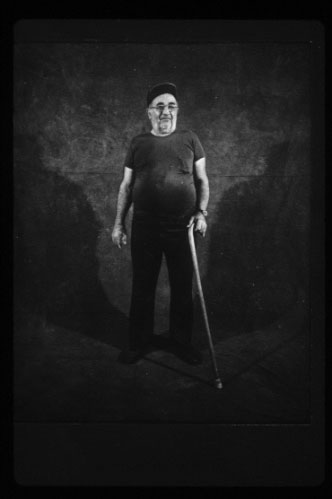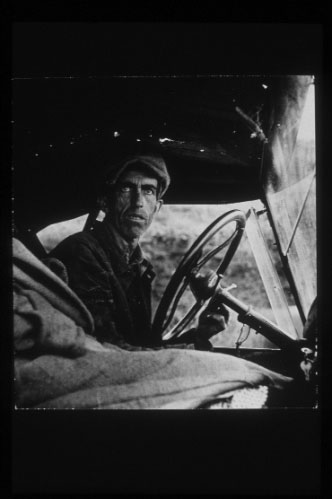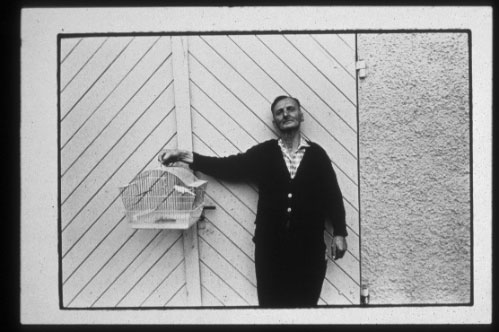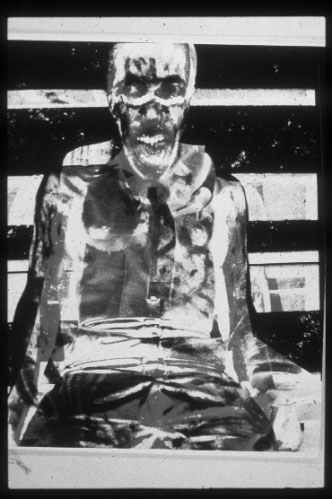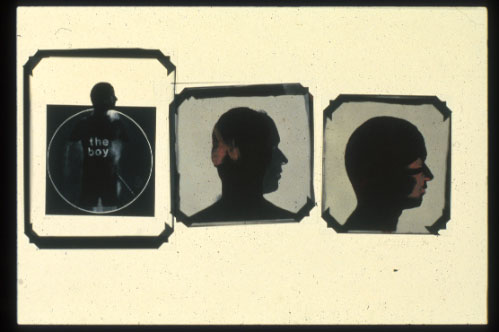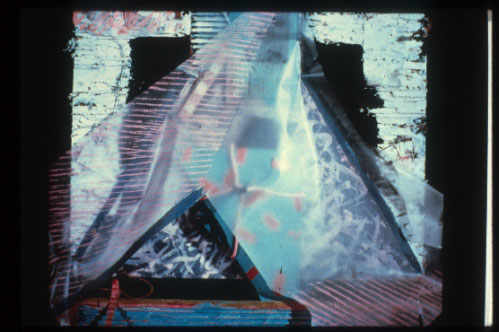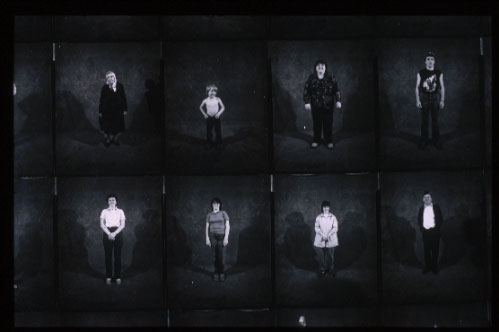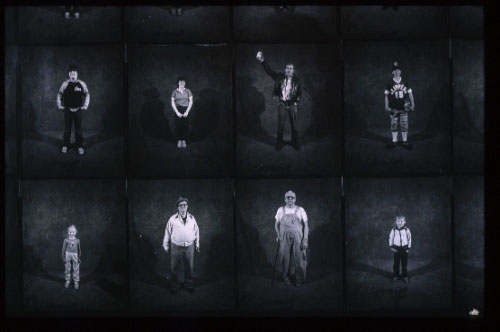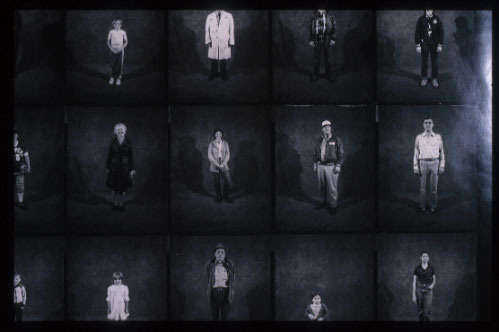|
"An
Artist Makes History: Peter Feldstein and Oxford '84" E-mail:
Richard-Horwitz@uiowa.edu Copyright
© 2020
Peter Feldstein is an artist and a teacher among other things. Away from home he is best known for his photographs. Some of them are permanently displayed in urban museums, national banks, and insurance companies. Others are featured every year in group shows and an occasional solo. Galleries in Los Angeles, Chicago, and New York show his 30-by-40 inch prints and sell them for $500 to $1000 each. Given the cost of working in cibachrome, even on Peter's do-it-yourself basis, sales barely exceed expenses. Art photography is hardly lucrative. But with a university appointment, Peter has the support to reach passionately for the limit of his art. Since the late 1960s his photographs have grown increasingly abstract. In recent ones you might detect the innards of a battery, fragments of painted glass, old plaster, wire, or paper. These are among the elements of Peter's subject, his "constructions," but the photographs are not quite pictures of anything. They evoke more general ideas, concepts of vibrancy and color, tensions between plane and line or shadow and depth. The best pictures do not "catch" or render a subject; they "work."
I must admit that they do not work very well for me. My sense of fine art is embarrassingly crude. The only modern art I readily appreciate is a folk variety. Since the late 1960s, I have used my university salary to pursue the extraordinary experience of more ordinary working people, plumbers more often than poets or artists. After seven years on the same Iowa campus, Peter and I recall only that we might have met. We met more memorably in the Spring of 1984, when corraled by a mutual friend, state folklorist Steve Ohrn. Over a beer, Peter explained his plans for the summer. He had to teach, and he vowed to continue restoring the aged store front where he lived. With the remaining time he wanted to photograph everyone in his town -- one at a time, all 700 residents of Oxford, sixteen miles west of Iowa City. He would put full-body views on 4-by-5 inch black-and-white film. People would be encouraged to come and pose as they choose: "Just be comfortable." But they would all stand against a plain background, an old tarp in front of a fixed camera and lights, in a vacant downtown office (courtesy of the mayor) across the street from Peter's "house." He would contact print the negatives, 50 to 60 at a time, on massive sheets of paper. The effect would be something like the seniors section of a high school yearbook: "Oxford '84." The Iowa Arts Council (sensing a good way to bring Culture to the prole) already agreed to pay about $1000 for materials. This would be, then, a remarkable shift for Peter. He would begin making, not only pictures of things, but also pictures of people, subjects who can be busy, forgetful, or ornery. I could not imagine their total cooperation, even with the unified support of Iowa Rotarians, Girl Scouts, and 4-Hers. Moreover, Peter was working in Oxford, a notoriously unruly place. While nearby villagers commemorate a late pastor or friend of Herbert Hoover, Oxford folks recount rowdy escapades of yore. Like other Midwestern boroughs, Oxford has long shown signs of dying, but this one will go down raising hell. I could not be sure how Peter's neighbors would greet his plan. But I knew they would not lie there like studio constructions. It would also be a remarkable shift for me. Steve and Peter first guessed I might offer generic prose -- a sketch of smalltown Iowa or biographies of the folk. But I resisted. The more challenging focus would be Peter himself. Why would an abstract artist want to make, in his words, "an objective record" of Oxford, 1984? He said he was making it "for posterity," for "history." But what sort of history would he make? Of course, the short answer is in the photographs themselves. They are simple, direct, and amazingly complete. Peter captured 670 people on film, 95% of the town, including invalids and infants. The small number of omissions can be attributed to truly extraordinary circumstances. Door prizes would not have helped. Patricipants seem pleased with the results. They glance through the pictures: "Oh yeah, there's so-and-so! Isn't that just like him? Wouldn't you know he'd wear that hat. I wonder what his sister thinks of it . . ." No one complained of distortion, favoritism, condescension, or any other sort of bias. They had come as they are, and that is what they saw: "Won't it be great to look back at these when the kids are grown? We ought to do this every few years." Cynicism was imperceptible, even among the town's most notorious delinquents. They claimed the photos as their own, "our" pictures for "our" history.
In a sense, they are simply right. With few exceptions, people dressed and stood as they might for a family candid on a Saturday afternoon. Peter just provided the occasion. Some people chose to bring props, a guitar or a pet; some gestured, smiled, or scowled. And somehow, most agreed, they were comfortably and characteristically "themselves."
No one was forced to participate. Prodding was purely local -- the mayor, Post officers of the American Legion, neighbors. For the first couple of weeks only children and old-timers readily posed, and a few (most often middle-aged men) rudely refused. Peter became discouraged. But within two and a half months nearly everyone joined in. Some came because they felt close to Peter or sorry for him; some because they were curious or nagged by the right kin; some because the project was good for the town or too petty to resist. But in the end the pictures were truly collective creations. Truly but not thoroughly. Peter was the one who had the idea, who donated hours in the darkroom and money when the grant ran out. He chose the equipment and the format, the repetitious grid that so strikes out-of-towners. He chose the time of year. (Who, besides an academic or a Jew from New York would start a community project when there is cultivating, first hay, and side dressing to do?) He was the one who explained how to "come as you are" -- not dudded for a formal portrait or busy on the job, but as you might look at home on the weekend. Certainly people could have been "themselves" in their uniforms or Sunday-best. For example, one teacher countered that no one would even recognize him without a jacket and tie. He posed, though, in his gardening pants and an open shirt. Peter also controlled the negatives. He decided which ones to reshoot and which duplicates to neglect. He arranged them (albeit "pretty randomly") in the contact prints. He greeted and faced every child, man, and woman as they stood. For posterity the pictures are his no less than theirs. I do not mean to suggest that Peter abused his control. He was not trying to use it for any clearly premeditated purpose. In the beginning, Peter admits, he was infatuated with Oxford, and he thought the project might boost local spirits. Like a 1950s sociologist he rhapsodized community -- intimacy, irrationality, tradition, and guts. He would not have to compose each picture because the subjects would do it. Just being themselves, they would be interesting, naturally. He held that view even as I and his wife expressed our doubts. But when some of the neighbors showed they could be suspicious or rude and when some of the portraits came out undeniably dull, he began to change his mind. He still deeply cared for the town but now less blindly. Even so, his changes of sentiment did not affect the portraits. In July as in May, people were photographed as innocently as they stood. Peter aimed for a form and a process, not a particular effect, least of all simply to flatter or condemn his subjects. That is how he works. A friend confided, "Peter is less a photographer, painter, or sculptor than a bricoleur." He plays with ordinary art supplies and found materials. He discovers what he will make as he makes it. All of his art, then, this "objective record" like his abstractions, is a changing mix of Peter, his subject, materials, concept, and craft.
The mix is barely evident to most of his neighbors. They look through the pictures to the subject, familiar signs of Gina or Bob. The mix is just as obscure for strangers. They look for tributes or parodies of solemn Iowans. Or they find "rhythms" among the portraits, as if they were product codes. But as Peter talks about the project and his earlier work, the quality and significance of the mix become more evident. * * * The idea for the Oxford thing just came to me out of the blue. About three or four years ago I mentioned it to somebody at a conference, and they evidently told this woman on the Arts Council. She came to me all excited: "Oh, what a great idea. Do it! We'll get you the money, etc. etc." But I wasn't really ready to do it. I wasn't really interested until there was this meeting at the firehouse a few months before, February or maybe March of '84. It was for people concerned about downtown Oxford, how to make it more appealing. The organizer was a young fellow who's trying to start a grape-growing business here. You know, I own two buildings downtown, the one I live in and the place next-door. And Don, the mayor, was there. He owns three or four places across the street. We comiserate with one another about our renovation projects and stuff like that. I like him a lot. He wants to do things to promote the town, and he's interested in history. He has this dream, for example, of fixing up the old firehouse and the antique truck. He found a tape of a speech President Truman gave at a whistle stop in Oxford. He wants to set that up somehow. The guy who works in the garage around the corner was there, too. There was a bunch of people. But there was this one couple . . . fascinating. They looked like they'd stepped out of a Dorothea Lange photograph of migrants in the 1930s. There's one that particularly sticks out in my mind ["A Missourian, headed west, asks directions" or "Ditched, stalled and stranded, San Joaquin Valley, California" (1935)]. The guy had that sort of gaunt and intelligent look. There was an elegance about him different than most of the men I'd met in town. The same with his wife. Her look was even more gaunt. She looked like she'd been through a lot. I couldn't take my eyes off of them all night.
Right then I said, "Geez, I'd really like to photograph these people." It evolved from there. I hadn't been doing any kind of photography remotely like portraits or documentary. But there was something about them that I really wanted. I think, more than anything, it was like the reasons I photographed when I first started. I wanted to meet them, get to know them. As a student and for the first years after, I did portraits. They were mostly candids of people on the street, oh, back about 1966, '67 through '70. My biggest influence was Paul Strand, because I did my thesis on him and I was interested in his work. It had to do with the direct confrontation, a very frontal approach. I always insisted on having some kind of dialogue with whoever I was photographing. I didn't want people to just stand there, waiting for the picture. I learned to involve myself and evoke a sort of physical response. (I must have some old ones around here that I could show you. I don't have them in any kind of order.) Yeah, here's some. These are later ones. The work did start to change at one point, but it didn't happen all at once. In art school I took print-making, painting, sculpture, a lot of drawing classes. "The art influence!!" Ha! A lot of my work has been somewhat painterly. But as a painter or draftsman you can put what you want in the frame; as a photographer you go about it differently. I was interested in using the frame to create a tension, a vital kind of spatial tension. I can't say I was as aware of it then as I am now. A lot of it was sort of natural at the time. Now I'm much more concerned about it in a very different kind of way. (It's funny. Talking about these is like talking about somebody else's work. It was so long ago.)
It got real frustrating. For me, the act was going out and photographing, and the rest of it was boring. I made good enough negatives so I could come back and just print, knock them out basically. I hated working in the darkroom. But I loved drawing, being able to work and rework images. That's what I was interested in. But you couldn't do it with photographs, and the drawings weren't interesting either. I stopped drawing. The work didn't seem to be going anywhere. I was teaching photography and working in labs -- St. Louis, New York, Massachusetts -- earning next to nothing and doing a lot of hack work. Manipulation was something that just "wasn't done." You know what I mean? I don't mean I was in the vanguard or anything. Even then there was a lot of people trying to go beyond the straight photograph. But there was a lot of opposition -- like followers of Ansel Adams, F-64, . . . -- where the quality of the image, the purity of the medium, was the most important thing. They were real conservative, and in some places those people are still in power. I never could understand what they were talking about. Now, no one gives a shit, because there's been so much cross-fertilization between painting and photography and all media. But at the time there was a lot of resistance from some quarters to anything beyond the straight image. Back about 1970, I did one that suggested some possibilities for manipulation -- sandwiching and drawing, that sort of stuff. But I had no idea where the image was or where it came from. I just had an old negative of my father's that was of my cousin and me when we were kids. I made copies and flipped some of them and put them together. It was just this strange image, but it was the start of at least thinking about ways of manipulating photographic materials. I didn't know what to do with it. Mostly I was just doing that other work, real frustrated. It wasn't going well at all that year in New York. Then this friend of mine, Ben [a pseudonym], committed suicide. That really changed things. There were three of us who were good buddies. (In fact, I've got our picture around here. We had a show together up in Nazareth College or something, Upstate New York, and Ben got his wife to photograph us for the poster.) So his suicide was very difficult. I had to go to the morgue. They even sent me the autopsy report. What a freaky thing. It describes this human body, every blemish, every organ weighed. I was freaked out. For a year I piddled around in New York and Boston. I did a lot of my own work just at night and on weekends. One day I went to the darkroom with a bunch of stuff -- graphic arts films and pencils, erasers, ink, paint, and scissors -- cut-and-paste stuff. I just started putting things together. The first ones all used images of Ben. Like, I had an old negative of mine where he was horsing around, in a pose like he was hanging, which is how he committed suicide. I used drawings from the autopsy report. And I used some other images, some of my mother that my father took and that, I thought, were rather grotesque. See, like this triptych? (This one isn't a finished print. I used it for the back of something else. But you can see.)
They are some of the strongest things I've ever done. They came out of this work with Ben, the stuff that kept me up at night. I still shudder at them. I call it my "autopsy series." God, those things kept me up for years! Death, I guess. I just couldn't understand it. It became like an obsession. But after those early ones, 1973, I moved to Iowa, to a farm. We had 60 cows and 47 calves. After a while, I burned out on death. I guess it was just that . . . on the farm something was being born and dying everyday. I realized that was what it was all about. Near the end the questions were more about my own life and death. So, I started using images of myself: real self-conscious stuff. I covered my face with oil or water, put baby powder on it, and photographed it with little combinations of things. See, a Jewish vampire! Ha! I loved that baby powder. It was real silly stuff, like a grade-C Hollywood movie: fun but ridiculous.
I wasn't really interested in that work anymore. I was just experimenting with materials, starting to draw more, doing Kwik prints. Things were obviously getting much more intricate, painterly, and out-of-hand in a way. I was moving too fast into something that I really knew absolutely nothing about. They have a slickness that comes when you first learn something. You think you know it, but you don't really have the body, the substance behind it. You know what I mean? Like, that triptych with Ben has the whole history of our involvement behind it. Then I got to this other work. I had no idea what I was doing. I was just playing around. And in some ways, I think they work because of the freedom, the freedom that ignorance gives you. But then, all of a sudden, you get to a point where . . . you are past the point of ignorance but there's nowhere to go. You know what I mean? So, I started doing some real dumb things with color and light. They're pretty, I guess. I like looking at them. I'm interested in how other people do it. But the idea doesn't really affect me. They're boring. I'm not interested in going around, looking at the way light falls on this or that. But I was doing that kind of junk. In 1976 I quit photography. I went back to drawing. One of my friends had always talked about drawing as mark making, and I really never understood. I never was interested in drawing as rendering, so I just tried to see what I could do making marks. I did a lot. I worked day and night just scribbling to see what happened. (Here, I can show you some.) I have tons of them. Some of them aren't very good . . . pretty awful in some ways. The more minimal ones I like a lot. It gave me a freedom that I hadn't had in a long time, too. See, the earliest ones were the best ones. Really, that's what happened! Later I got into some real mechanical things that I liked, but they were boring to do. Anyway, at the time, 1977, Lynton Wells, a New York painter, was visiting here. Looking at his work, I realized that I could make marks with photography. I took a piece of glass, some paper, wire, chalk, the base of a lamp, an orange extension cord . . . and just started playing with them. I could use anything for making marks: the wire, for example, as line; the glass as something with depth. (I like this white, sort of cosmic dust. That's non-dairy creamer.) They started getting flatter and flatter. They got more interesting to me because there really was no space. They were flat, but there was a suggestion of space just by the use of the materials and the relationship of the shape and the form. (God, I still like some of these!)
I started drawing more. And I stopped using anything in the photographs that was identifiable as a product, like a beer can or TV. I wanted them to be more abstract. I started using parts of an old battery that I found smashed open. I used fragments of glass and plaster from my building when I was tearing out the walls. I tore up a bunch of old drawings and used some of the pieces. (I found the pieces more interesting than the drawings.) I'd drag all that stuff back to the studio, set it up on a table, and photograph down on it -- very flat and as totally abstract as possible. See, when things are photographed there is always going to be a question about that: "What is it?" I still have that problem. People will say, "Oh, from a distance I thought it was a painting." That bothers me, and it may be a problem with the work. They're not what they are. So, I make them as abstract as possible to avoid the reference. Like, some people have suggested that I show the object and the photograph together. And I've never really wanted to do that. Somehow, the photograph still leaves a mystery about the look of the object, especially in terms of scale and space. I'm trying to create an illusion of space that doesn't really exist.
So, this is the sort of thing I've been doing since the mid-'70s. The first stage was documentary on the street, the second was autopsy and death, and now this. Even this has changed a lot as I have changed the size of the constructions and the prints, the materials, the colors. Everytime you change one thing, other things have to change in ways you couldn't anticipate. Often I've found, for example, that the objects that worked the best were not the ones that worked the best as photographs. And often the ones that worked best as photographs didn't work well as objects. For the past couple of years I've mainly been changing the constructions to see what happens. Maybe that's why I'm ready for the Oxford thing now. I'm doing these constructions, and I'm not doing as much photography in my other work. So I feel comfortable doing something that's much straighter. Also, I've been learning a lot from doing it that has almost nothing to do with the process of making the photographs, a lot from the people. Besides, I'm tired of hitchhiking into Iowa City every time my Volvo breaks down! Ha! One reason, too, is the technical challenge. Like, when I agreed to do that poster for the University last year, I had no idea what I was getting into. They just wanted the inside of the Arena. I thought, "They'll buy me this camera, and I'll get to watch some basketball games. I'll go out there and shoot it." But then I found out that there were all kinds of questions: How high the camera would have to be (there's no viewfinder on a panoramic camera), the speed, how to deal with the fact that the light is so bright on the floor but falls off so much at the top. There were problems with the camera. All sorts of things. But, like I tell my students (and I always apologize for it, because it's so corny), my grandmother used to say, "If a bird doesn't jump from the branch, it will never learn to fly." Real corny, but true. If you don't take risks, you don't learn anything. I always try to jolt myself, like putting down colors that don't work and making them work. My mother, to this day, makes comments about how I used to be as a child: real clean. She would make me little suits with my name embroidered on them. I could go out and play in the mud and never get a spot on me. Obviously, you can see by the way I look, I'm hardly that way now! And I think the work has both aspects. In some ways I'm anal compulsive, and in other ways I'm the opposite (whatever you call that). Anyway, the Oxford thing has technical challenges, too. One of the other things about doing this project is that . . . for the last year, year and a half, I've been a little dissatisfied with the work. It has to do with social responsibility. I don't know how to get back into that. I'm not sure that I need to or that I should. What good does it do, anyway? I have questions about that. But, see, I'm 42 now. I was involved in the Civil Rights Movement as an undergraduate and then the anti-war thing as a graduate student. And now what I see is that we've gone back to before that point, because nobody is doing anything. I'm just saying I feel guilty in some ways. My work is this stuff I do in my studio in this ivory tower. But, you know that triptych I showed you? When I first did that, I had it up in my living room, and my mother screamed, "How can you live with that everyday?! They're powerful images and wonderful and everything, but how can you live with them? How can you do them?! How can you do something so ugly? You have such a great sense of humor. Why don't I ever see it in your work?"
I didn't know how to answer her at first, but I thought about it later. I realized that we all have things we're able to do best in one way or another. I can sit around with my friends and tell jokes. As a matter of fact, that is what I would prefer. Wheras, William Wegman . . . (Do you know his work? like the photographs of his dog?) His stuff is hysterical! Wonderful. I love it! It's his vehicle for dealing with his sense of humor. Sitting around with his friends, he might be deadly serious. See? I felt I was dealing with things I couldn't talk about. I couldn't talk about questions of life and death and all that at the time, because they were like splinters under my fingernails. So now I have this other stuff that's bothering me, and I wonder if there is a way to get at it. The Oxford thing may be a way. I don't know. * * * The stuff that bothers historians, the official guardians of posterity, is supposedly less intimate. They simply want to "get at" the past in any way they can. Peter has left them an invaluable resource, whatever his private purpose. Hordes of future graduate students might extract meaning from his photographs ("the visual text") like giddy Forty-niners.
They might count the people; sort them by ages, genders, and statures; note the uniformity of their complexions, and the patterns in their postures. Men and women, for example, trade brazen and coy stances, sucked-in guts and canted heads, while children, new to such subtleties, stare blankly into the lens. You could not ask for a better sample of Midwestern, smalltown, summer-weekend fashion: gingham dresses and blue jeans, chore boots and jogging shoes, seed-company caps and message-laden T-shirts. Curators in the next century might well use "Oxford '84" to justify collecting strollers, guitars, baseball mitts, school bags, and beer cans.
Scholars of a more scientific bent could use the photographs to reconstruct public health and social structure. Children, for example, stand straighter and taller than grandparents raised on more limited local produce. Eye glasses and walkers are common among the aged and athletic gear among the young. (It is easy to see that weight loss has not been as universal an American fixation as the popular press might suggest.) With a little documentary material -- a directory or two, party and church membership lists, maybe some K-Mart and Sears advertisements -- analysts could learn to see, as the locals do, that each class and clan has a characteristic look.
"Oxford '84" could be of special interest to art historians. They might use it to mark a stage in the evolution of documentary photography or institutionalized art. Independent entrepeneurs, like the artists who struggled before the F.S.A. or W.P.A., could rarely afford such an undertaking. The marketing and distributions systems prohibit it. But with funds from a state arts council and a university salary, Peter is able to craft a gift for his public. Indirectly, at least, they paid for it "on spec." Of course, Peter hoped they would be appreciative, but only the Arts Council had to worry about it.
Critics might emphasize the more formulaic "art look" of the photographs. Granted, like Uncle Harry and the Sears Studio, Peter centered each subject in the frame. But he used black-and-white film. The background was not a swing set or a scene from the Rockies but an old tarp. With minimal lighting and long exposures Peter left shadows and motion that would be considered defects in a commercial portrait. The repetition of simple, geometric images in the composite is a modern art convention. It is not surprising, then, that more galleries than archives have been interested in displaying the work. But Peter did not have scholarship or criticism in mind. I remember him in the darkroom one day, toying with the order of the negatives for a composite he would give to the town. He started talking about "balance" and "rhythm" in a sequence but then stopped: "What the hell. They won't give a shit, and in a way I can see their point." He could worry about that stuff in future editions or in what he half-jokingly calls his "regular" or "real art." Yet too, with the benefit of Peter's commentary, we can see that he was not just taking a break from art or Iowa City. The project could not have been done as it was without the University or the art world. Although the photographs may look tangential, they follow main lines of his professional career. Paul Strand, Dorothea Lange, teachers, and colleagues look over his shoulder. Images of 1930s migrants, Wegman's dog, old photos, drawings, and constructions hover over the work. Ventures into unknown territory are not flights from his craft but a regular part of it. As an undergraduate he studied sociology; as a graduate student, fine arts. His early work was representational; his later work abstract. It is only natural that he would use the Oxford project to explore the change. But in an art world, especially one so insulated from the market place, the line between craft and personal expression can be very thin. The project was for Oxford, but Peter was also making deeply personal history. Looking over his shoulder, next to (or maybe even in front of) Paul Strand, is Peter's mother, his father, cousins, and neighbors. Private images of 1960s marches, Medgar Evers, and body counts face Jerry Falwell and Ronald Reagan. Peering from behind all those gingham dresses and faded jeans is the ghost of a dead friend. I cannot help feeling a little sorry for Peter. The feeling hauntingly resembles my own self-indulgence. With others of our generation, we often ache like weary veterans, if not from The War or discrimination than from futile movements to stop the madness. About the time Peter moved from New York to his Iowa farm, I moved from Rizzo's Philadelphia to smalltown Maine. There we hoped to heal or at least forget our wounds. But they still fester, and many of us cannot forget. I remember the long drive from my house to Oxford on Memorial Day, 1984, worrying for Peter. It was to be the deciding day of the project. He could not understand why so few people had come to pose. It was such a great idea. But with Memorial festivities downtown and more aggressive support pledged by town notables, surely (we all prayed) they would come flocking in . . . if the weather held up. As the temperature dropped and rain began to pelt the windshield, my worries increased. I stopped at a store near town to check what was happening: "Oh yeah, the parade has been cancelled. Some people may just drive out to the cemetery." Oh, God!! I readied for the worst, rehearsing soothing speeches as I turned into Main Street. There was a line of people standing in the drizzle in front of Peter's makeshift studio. It could not be all that bad. In fact, it was wonderful. Most of the town was across the street whooping-it-up at the American Legion Hall. Post Officers were grabbing whole families and dragging them over to pose. Peter was overjoyed and exhausted, cranking out forty or fifty shots an hour. His arm was killing him just from loading and unloading film holders.
At noon we demanded a break to eat some chicken fried by the Auxiliary and to relax over a beer with friends. People started buying Buds for us faster than an ordinary human could open the cans. "This is a drinking town," they boasted. "A goddamned good time," Oxford-style. Since I had been standing, talking, and listening all day, I eventually left my beers stacked on the bar to sit in a corner, rest, and work on my notes. I paused to look around and eavesdrop. Surrounding me were ruddy Iowans in Sup-hose and military garb, cursing, back-slapping, and above all getting drunk. Housewives, huddled at tables, nervously looked on as their kids wrestled under the chairs. It finally occurred to me: "What are two Jewish long-hairs from the East Coast doing in a place like this?" I whispered something about it to Peter who chuckled and went back to his conversation. Soon he was dragged out the door with a crowd to return to work, and I filled his place at the bar. More beers piled up. Most of the time I chatted with a man I'll call "Jim." He forgave my taking notes as we exchanged bawdy hometown tales. Every few minutes I would ask him to wait while I caught up. But as I wrote, I noticed that neighbor after neighbor came up, hugged Jim's shoulders, looked him straight in the eye, and softly said, "You know we're all with you today." Jim would look down at his beer a little sadly and say, "Thanks. Hey, I'm okay. We have to look to the future, you know." How could I have forgotten? That morning in the cemetery Jim had walked by the grave of a son who died in a car wreck just weeks ago. Of course, I was not expected to know or to say anything. We were supposed to be having a goddamned good time. But I felt sad and more than a little ashamed. Down-home folks have good times but also complex lives and wounds of their own. Right then at the bar, I took some of Jim's words (mainly things he said as he shifted from receiving comfort to talking with me) and edited them into a single paragraph. I read it back to him and a few others who paused to listen. "That Peter is something, I tell you. He moved here from New York, you know. But I don't think he'll ever go back. He likes it in Oxford! Really!! . . . Just having fun . . . We've got him about wore out, working like a peach orchard boar. But hey -- that's what it's all about. You know, if you're sick here, someone will take care of you . . . and . . . then again, if you're an ass hole, forget it!" "That's right!," they said and laughed, "You've got it!" In the end I am not sure anyone of us entirely got "it," the real Oxford '84. But Peter, the townsfolk, and I did our best. Through the project we came to know and care for each other. We learned to see parts of ourselves, new memories, and old dreams in Peter's gift to posterity -- "a little slice of history" we made together. |
